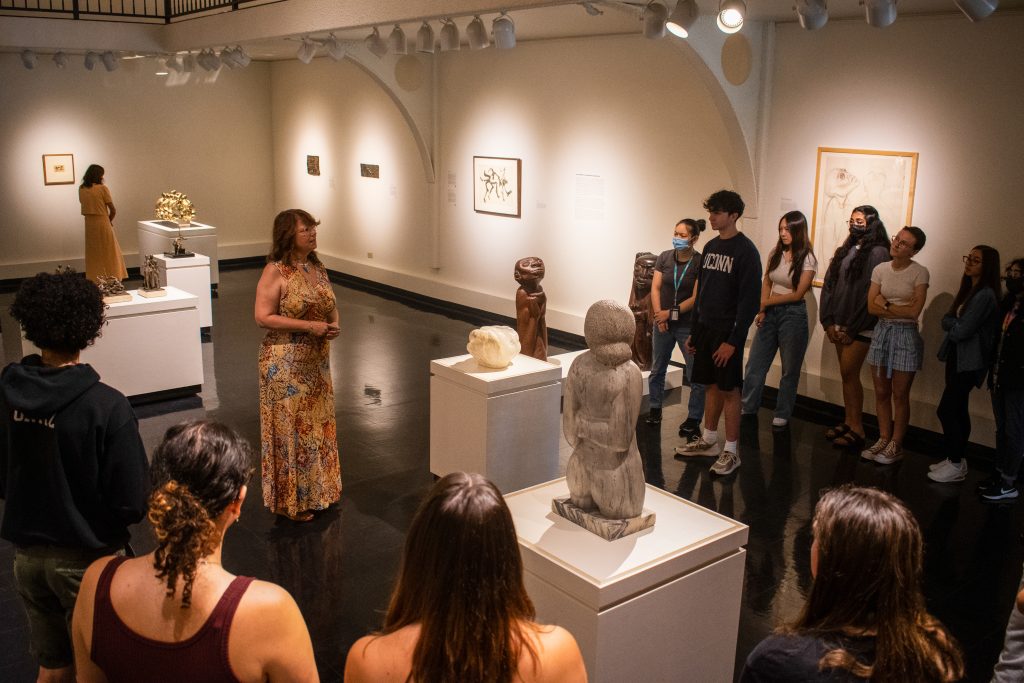Black art and Binghamton’s history come together in the Binghamton University Art Museum’s newest exhibition, “Ed Wilson: The Sculptor as Afro-Humanist.”
The main exhibition features the sculptures of Ed Wilson (1925-1996), who served in the studio art department at BU. Created as a result of the BU Art Museum’s investment in collecting work from Black artists and donations from Wilson’s family, the exhibition chronicles Wilson’s prolific 45-year career. The sculptures capture the richly complex history of the Black American experience, bringing together the history of Black culture, struggle and resilience.
The BU Art Museum unveiled “Ed Wilson: The Sculpture as Afro-Humanist” with a reception on Sept. 7. The show serves as the first retrospective exhibition of Wilson’s art since a showing at BU in 1964. Featured work included Wilson’s portraits of friends and fellow artists, bronze relief sculptures exploring the history of American jazz and sculptures of famous figures such as Frederick Douglass.
Tom McDonough, organizer of the exhibition and professor of art history, wrote about his inspiration for curating the exhibition.
“I ‘discovered’ Wilson’s work while working on an exhibition of African American art for the [BU Art] Museum around five years ago,” McDonough wrote. “The [BU Art] Museum had a handful of works in its collection and I thought — wait, who is this guy? It just piqued my curiosity. The more I began digging, the deeper my fascination became for him, his work and his life.”
The exhibition pays homage to Wilson as a valuable member of the BU community, multifaceted artist and deeply committed civil rights activist. The displays demonstrate the wide reach of Wilson’s work from the 1950s to the 1990s, ranging from personal pieces to sculptures created for commissions, including his “Falling Man” memorial to John F. Kennedy after the president’s assassination.
Claire Kovacs, curator of collections and exhibitions at the BU Art Museum, expressed appreciation for Wilson not only as a public figure, but as an artist whose work reflected familial themes.
“It’s a really exciting exhibition,” Kovacs said. “Showing work from throughout his working life — from early sculptures all the way up to sculptures toward the end of his life — showing examples of public sculpture all the way through to some very beautiful, more intimate works of his children.”
The process of acquiring pieces for the exhibition involved connections between the BU Art Museum and museums that house Wilson’s art, such as the Howard University Art Gallery. Additionally, Wilson’s children supported the BU Art Museum by donating pieces for the show.
Utitofon Inyang, assistant professor of Africana studies, discussed a particularly resonant piece of artwork displayed at the exhibition — Wilson’s plaster portrait of Ralph Ellison, author of the novel “Invisible Man.”
“I read the ‘Invisible Man; as an undergrad back in Nigeria, in an African American literature class,” Inyang said. “So the connections, the intersections are just very unreal.”
Jaden Eyzenberg, BU ’22, described his impression of Wilson’s art as a statement of civil rights.
“I got the sense that Wilson, over the course of his worthy career, tirelessly sought to turn the racist injunction of African American invisibility on its head,” Eyzenberg wrote. “In masterful fashion, in his statues and sculptures, varied in form, method and vocabulary, is the singular aim to trespass into the realm of the Caucasian cognoscenti and announce, bold and Black, that they will not be mocked from on high.”
McDonough also commented upon the resonance of Wilson’s art in the sphere of civil rights and racial justice.
“I think Wilson reminds us of the power we all possess to change the world for the better,” McDonough wrote. “His art has its own power to teach and inspire. In a present moment that can sometimes lead us to despair, he offers us an inspiring model.”
“Ed Wilson: The Sculptor as Afro-Humanist” will remain on display until Dec. 9. “Memory and Soul,” the main gallery’s companion exhibition that also highlights Black art, will also close on Dec. 9. Visitors can view both exhibitions free of charge during museum hours.



